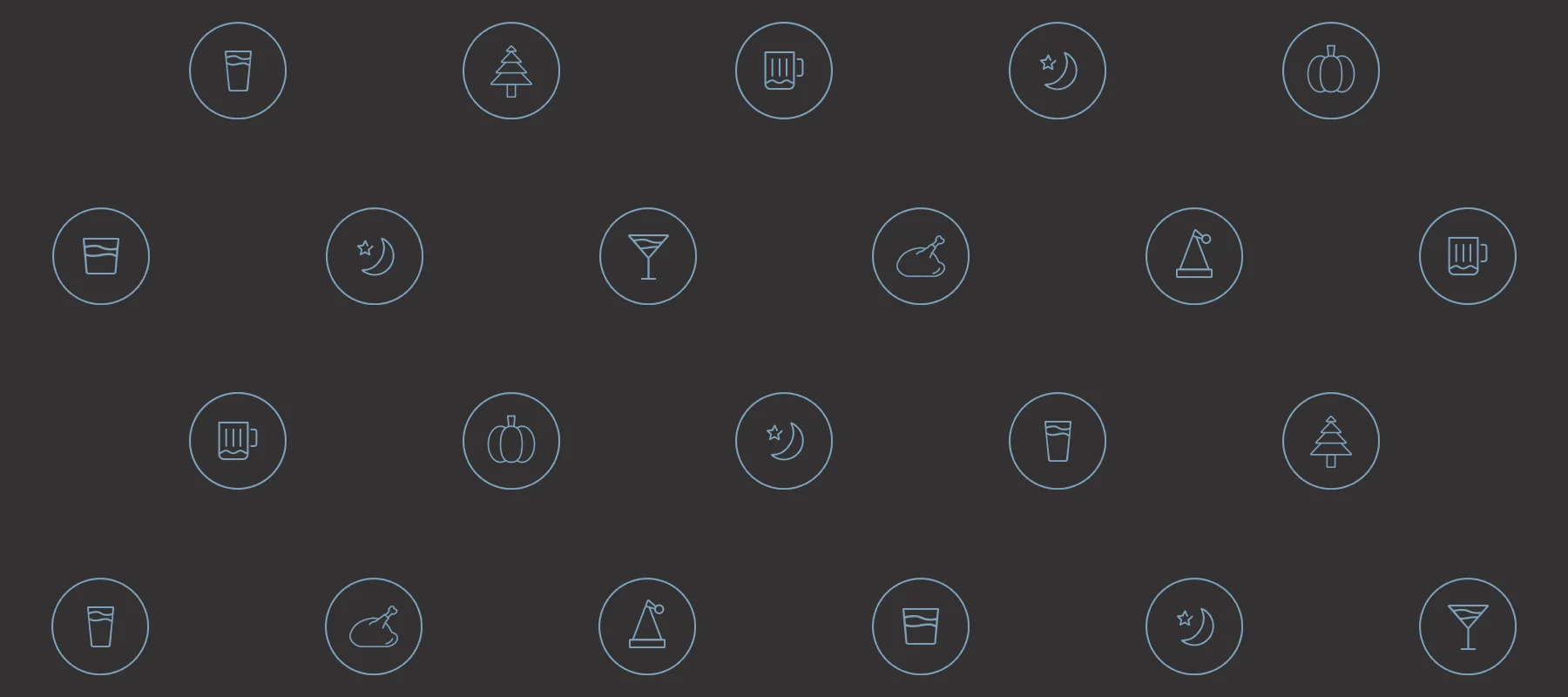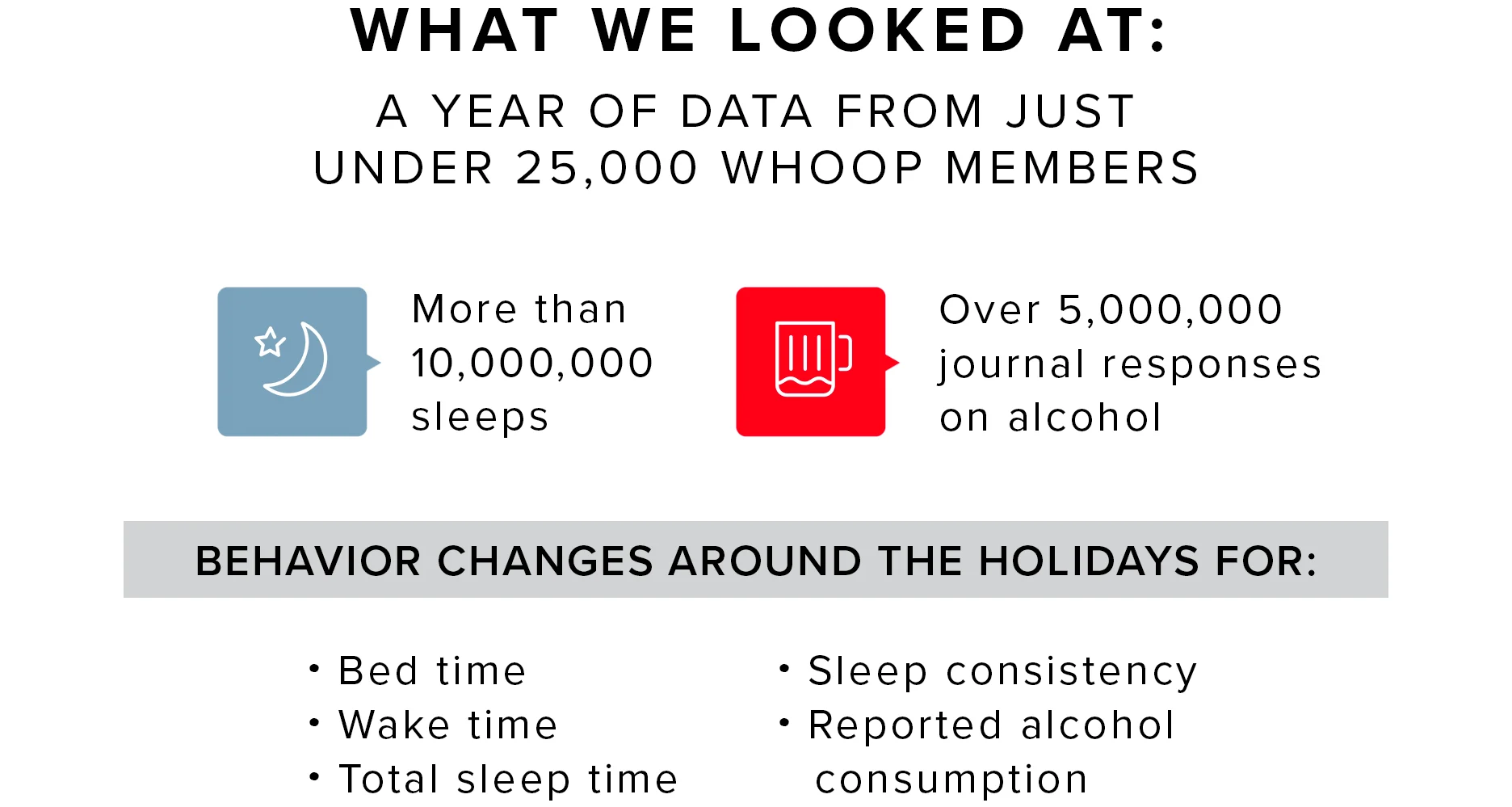Topics
- Article
- Behavior Impact
- Health & Wellness
How Much More Do We Sleep and Drink Around the Holidays?

We examined a year of WHOOP data to help better understand changes in sleep and alcohol consumption during the holidays.
Holidays tend to be parts of our year that we look forward to. The chance to unplug from work, spend quality time with family and friends, indulge in good food, and generally recharge are all reasons we welcome these occasions. We think of this time as a break--but how much of a break is it really for our bodies? We often also use holidays as an opportunity to switch up our sleep patterns and maybe have an additional cocktail before bedtime since we don’t have to wake up for work in the morning. As we know the value of sleep consistency, and how detrimental alcohol can be to recovery, we decided to study WHOOP members over the holidays to determine how much we really change our sleep and drinking behaviors.
About the Study
We analyzed the sleep and journal data of almost 25,000 anonymous, US-based adult WHOOP members from May 1, 2020 to May 1, 2021 to determine how members’ data changed around US federal holidays compared to their “normal” WHOOP data. Specifically, we looked at bed time, wake time, sleep duration, sleep consistency, and prevalence of alcohol use of these members. This amounted to more than 10 million sleeps and over 5 million journal responses about alcohol for us to study!

The study examined over 10 million sleeps and 5 million responses on consuming alcohol.
To understand the relationship between holidays and changes in WHOOP data, we compared the population averages on each holiday and holiday eve to a baseline. We didn’t want any seasonal or weekday effects to muddy the results of our study, so our baseline consisted of the average of 8 other days--the 4 days of the same day of week preceding the holiday or eve, and the 4 days of the same day of week following the holiday or eve. Using the baseline averages and the holiday averages, we found the average change in sleep and alcohol prevalence on each of the federal holidays and their eves. This illuminated which holidays correspond with significant differences in sleep patterns and alcohol prevalence and which seem to have little changes at all.
Average Impact of Holidays on Sleeping & Drinking Behavior
Bed time changed by around 16 minutes on average during holidays and their eves. Most differences in bed time were later bed times, when it was on average about 22 minutes later than usual. Each of the holidays with an earlier average bedtime were Monday holidays, indicating that members were likely taking advantage of the day off to catch up on some sleep during the work week. Wake time changed by almost 25 minutes on average. Most holidays were associated with sleeping in and on those days the average change in wake time was almost 33 minutes later. Similar to bed time, the only holidays that were associated with an earlier wake time were Monday holidays. As the changes in bed time and wake time indicate, WHOOP members were getting more sleep around the holidays. The average change in sleep duration on holidays and eves was 2.1%. Of the 20 holidays we analyzed, 15 corresponded to an increase in sleep duration for an average increase of 2.5%. Only two holidays corresponded to significant decreases in sleep, one of which was New Year’s Eve. Overall, holidays were associated with varying changes in sleep consistency--about half had an increase in sleep consistency and half had a decrease.

WHOOP members go to bed later, average more sleep, and consume more alcohol on holidays.
More people reported drinking alcohol when compared to baseline on almost every holiday we studied. In fact, the only day with a significant decrease in alcohol prevalence was on New Year’s Day (we expect most people were taking the day off from drinking after a big increase the night before, more on that to follow). The average change in alcohol prevalence, which we measured by percentage of “yes” responses in our journal feature out of those who responded, was just under 37% on holidays and their eves. Of those holidays associated with increases (about 70% of all the holidays we studied), the average increase was 46.7%.
Holidays With the Greatest Behavior Change
New Year’s Eve topped the charts for changes in bed time, wake time, sleep consistency, and prevalence of alcohol consumption. On average, members went to bed an hour and 29 minutes later and woke up the next day around an hour and 18 minutes later than usual on NYE. This big shift in sleep timing caused an average decrease of 13.8% in sleep consistency. Despite the later wake time on New Year’s Day, people still lost around 2.5% of sleep duration on average related to NYE. More than twice as many members reported alcohol consumption to bring in the new year when compared to baseline.

New Year's Eve causes the greatest changes in sleep and Drinking behavior.
Thanksgiving Day also stood out from the rest of the holidays for being associated with the largest average increase in sleep duration and the third highest increase in alcohol prevalence. Christmas Day had the second largest average increase in sleep duration and third highest increase in alcohol prevalence.
Why It Matters
This analysis shows significant sleep changes and increases in prevalence of alcohol use as a result of almost all holidays at the population level. These behaviors may provoke similar outcomes that previous research has shown comes from acute changes in sleep and alcohol consumption. For example, research surrounding changes due to daylight saving and vacation has demonstrated increased risk in adverse health consequences (vehicle accidents, workplace injuries, heart attacks, and all-cause mortality) when people are temporarily sleep deprived, particularly when alcohol use accompanies this sleep debt. On a more positive note, many of the holidays and eves are associated with significant increases in sleep duration that are larger than even the effect of melatonin on patients with sleep disorders, or the impact of cognitive behavioral therapy for insomnia. So while the additional drinking may not be particularly healthy, at least our members also use the holidays as a chance to get more sleep! Read the Full Study: Sleep and Alcohol Use Patterns During Federal Holidays in the United States